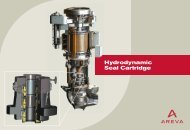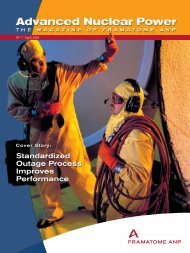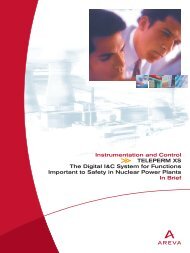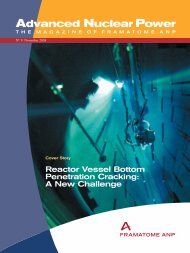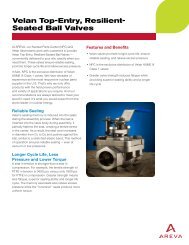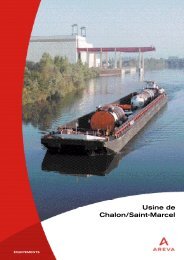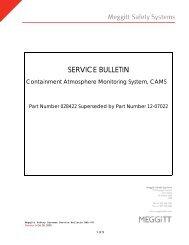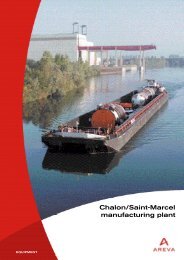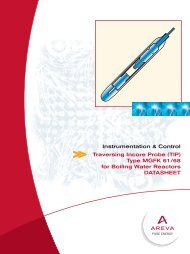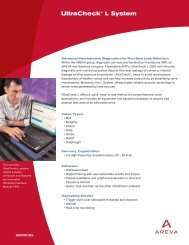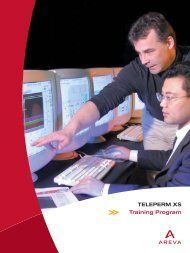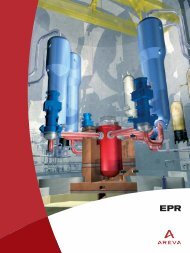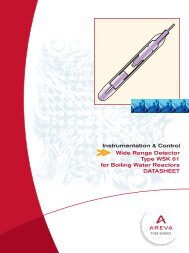Areva EPR
Areva EPR
Areva EPR
Create successful ePaper yourself
Turn your PDF publications into a flip-book with our unique Google optimized e-Paper software.
• EDF (Electricité de France), and the major German utilities<br />
now merged to become E.ON, EnBW and RWE Power,<br />
• the safety authorities from both countries to harmonize<br />
safety regulations.<br />
The <strong>EPR</strong> design takes into account the expectations of utilities<br />
as stated by the “European Utility Requirements” (EUR)<br />
and the “Utility Requirements Document” (URD) issued by<br />
the US Electric Power Research Institute (<strong>EPR</strong>I). It complies<br />
with the recommendations (1993) and positions on<br />
major issues (1995) that the French and German safety<br />
authorities jointly set up. The technical guidelines covering the<br />
<strong>EPR</strong> design were validated in October 2000 by the French<br />
standing group of experts in charge of reactor safety (“Groupe<br />
Permanent Réacteurs” which is the advisory committee for<br />
reactor safety to the French safety authority) supported by<br />
German experts.<br />
On September 28, 2004, the French safety authority, on<br />
behalf of the French government, officially stated that the<br />
<strong>EPR</strong> safety options comply with the safety enhancement<br />
objectives established for new nuclear reactors.<br />
Continuity in technology<br />
The N4 and KONVOI reactors are children of the earlier<br />
Framatome and Siemens KWU generation reactors which<br />
are themselves derivative of standard US type PWRs, first<br />
implemented in the US, then refined and expanded upon<br />
by Framatome and Siemens KWU. The <strong>EPR</strong> is the direct<br />
descendant of the well proven N4 and KONVOI reactors,<br />
guaranteeing a fully mastered technology. As a result, risks<br />
linked to design, licensing, construction and operation of<br />
the <strong>EPR</strong> are minimized, providing a unique certainty to <strong>EPR</strong><br />
customers.<br />
Operator expertise acquired through the operation of nuclear<br />
power plants using the same technology as the <strong>EPR</strong> is maintained<br />
and its value is increased.<br />
Another major advantage is that the existing industrial<br />
capacities for design, engineering, equipment manufacturing,<br />
nuclear power plant construction and maintenance<br />
– including capacities resulting from previous technology<br />
transfers – can be easily deployed and utilized to carry out<br />
new nuclear plant projects based on <strong>EPR</strong> technology.<br />
† The <strong>EPR</strong> relies on a sound and proven<br />
technology.<br />
† It complies with safety authorities<br />
requirements for new nuclear plants.<br />
† Design and licensing, construction<br />
and commissioning, operability and maintainability<br />
of <strong>EPR</strong> units benefit from Framatome<br />
ANP long lasting and worldwide experience<br />
and expertise. Therefore, <strong>EPR</strong> customers<br />
uniquely minimize their technical risks and<br />
associated financial impacts.<br />
Enhanced economic competitiveness<br />
The next generation of nuclear power plants will have to be<br />
even more competitive to successfully cope with deregulated<br />
electricity markets.<br />
Thanks to an early focus on economic competitiveness during<br />
its design process, the <strong>EPR</strong> offers significantly reduced<br />
power generation costs. They are estimated to be 10%<br />
lower than those of the most modern nuclear units currently<br />
in operation, and more than 20% less than those of the<br />
largest high-efficiency advanced combined-cycle gas plants<br />
currently under development (taking into account a gas price<br />
in the US$* 3.5 per MBtu range). The advantage over fossil<br />
plants is even more pronounced when the “external costs”<br />
(such as costs related to the damage to environment and<br />
human health) are taken into account.<br />
* In 2001 US$.<br />
This high level of competitiveness is achieved through:<br />
† a unit power in the 1,600 MWe range<br />
(the highest unit power to date), providing<br />
an attractive cost of the installed kWe,<br />
† a 36-37% overall efficiency depending<br />
on site conditions (presently the highest<br />
value ever for water reactors),<br />
† a shortened construction time relying on<br />
experience feedback and continuous<br />
improvement of construction methodology<br />
and tasks sequencing,<br />
† a design for a 60-year service life,<br />
† an enhanced and more flexible fuel utilization,<br />
† an availability factor up to 92%, on average,<br />
during the entire service life<br />
of the plant, obtained through long irradiation<br />
cycles, shorter refueling outages and<br />
in-operation maintenance.<br />
Significant advances<br />
for sustainable development<br />
The <strong>EPR</strong>, due to its optimized core design and higher overall<br />
efficiency compared to the reactors in operation today,<br />
also offers many significant advantages in favor of sustainable<br />
development, typically:<br />
• 17% saving on Uranium consumption per<br />
produced MWh,<br />
• 15% reduction on long-lived actinides<br />
generation per MWh,<br />
• 14% gain on the “electricity generation”<br />
versus “thermal release” ratio (compared<br />
to 1,000 MWe-class reactors),<br />
• great flexibility to use MOX (mixed<br />
UO 2 -PuO 2 ) fuel.<br />
I 03



